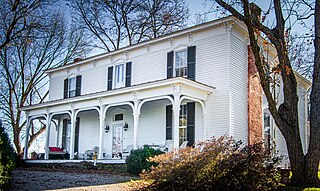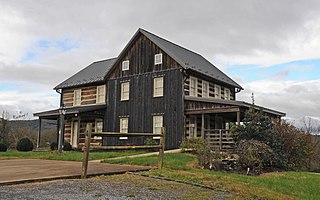
The William H. Copeland House is a home located in the Chicago suburb of Oak Park, Illinois, United States. In 1909 the home underwent a remodeling designed by famous American architect Frank Lloyd Wright. The original Italianate home was built in the 1870s. Dr. William H. Copeland commissioned Wright for the remodel and Wright's original vision of the project proposed a three-story Prairie house. That version was rejected and the result was the more subdued, less severely Prairie, William H. Copeland House. On the exterior the most significant alteration by Wright was the addition of a low-pitched hip roof. The house has been listed as a contributing property to a U.S. Registered Historic District since 1973.

The Connor House is an historic building located in Rock Island, Illinois, United States. It was designated a Rock Island Landmark in 1987. The house was individually listed on the National Register of Historic Places in 1988, and it was included as a contributing property in the Broadway Historic District in 1998.

The Thomas L. Critz House, built c.1887, is a historic Italianate style house in Thompsons Station, Tennessee that was listed on the National Register of Historic Places in 1988. It is a two-story frame residence with a Central passage plan. It has a one-story porch with square chamfered columns.

Rock Hill Farm, also known as the Davis-Stauffer Farm Complex, is a historic home and farm and national historic district located at Montgomery Township in Franklin County, Pennsylvania. The district includes 12 contributing buildings, 2 contributing sites, and 3 contributing structures. They are associated with three areas: the Davis-Chamber farmstead, Eliab Negley House, and Joseph Negley farmstead. Contributing components of the Davis-Chamber farmstead include the log and frame main house, 18th century log smokehouse, limestone milk house, frame wash house, frame outhouse, frame wagon shed, and a frame barn with concrete sile. The property also includes a stone wall, and the archaeological remains of earlier buildings including a limestone mill dismantled about 1930. The Eliab Negley House is a log dwelling built between 1810 and 1823. The Joseph Negley farmstead includes a Greek Revival-style dwelling built between 1836 and 1850, with later modifications about 1900. Also on the property are a contributing 19th century smokehouse, a frame wagon shed, and a large shed.

Colver-Rogers Farmstead, also known as the Norval P. Rogers House, is a historic home located at Morgan Township in Greene County, Pennsylvania. The original section was built in 1830, and is a two-story, stone dwelling, with a two-story stone kitchen wing, in a vernacular Greek Revival-style. The house was modified about 1906, with the addition of a gambrel roof and rambling porch with Colonial Revival-style design elements. Also on the property is a bank barn and large wash house.

Hamilton-Ely Farmstead, also known as the Evelyn Minor House, is a historic home located at Whiteley Township in Greene County, Pennsylvania. The house was built about 1835, and is a two-story, five-bay dwelling with a gable roof and blend of Federal, Greek Revival, and Colonial Revival-style details. The front facade features a two-story porch with Tuscan order columns. Also on the property are a contributing barn, spring house, wash house, and drive-through corn crib (1872-1874).

The Franklin Harris Farmstead is a historic farm complex located outside the village of Salem in Columbiana County, Ohio, United States. Once home to a prominent former soldier, the farmstead includes a high-style farmhouse from the 1890s, and it has been named a historic site.

John Bell Farm is a historic home and farm complex located in West Whiteland Township, Chester County, Pennsylvania. It was originally built in the 1840s and extensively remodeled in 1889 in the Queen Anne style. The original house consists of the two-story, five bay, stone central block with two-story service wing. When remodeled, the roof received a cross-gable and dormer windows. Also added was the two-story library wing, kitchen extension, and two-sided porch. Also on the property are a contributing spring house, tenant house, corn crib, and barn.

Brinton-King Farmstead, also known as the Joseph Brinton Farmstead, is a historic home located in Pennsbury Township, Chester County, Pennsylvania. It is a 2+1⁄2-story, stuccoed stone Pennsylvania farmhouse built in five stages. The earliest stages dates to about 1780 and 1795. Later modifications occurred by 1838, in about 1889 with its remodeling to the Queen Anne style, then about 1910. It features a wraparound porch with turned supports, spindlework, and round brackets. The house was adapted for use as a restaurant in 1948. Also on the property is a contributing 2+1⁄2-story, stone and frame bank barn with a gable roof.

W. H. Applewhite House is a historic plantation house located near Stantonsburg, Wilson County, North Carolina. It was built about 1847, and is a two-story, three bay, single pile, Greek Revival style frame dwelling. It has a one-story, shed roofed rear wing. It features a double-gallery porch with sawn ornament and trim added about 1900. The house was remodeled about 1870–1880. Also on the property are the contributing tenant house, packhouse, stables, sheds, and tobacco barns.

Marion House and Marion Brothers Store also known as Jubal E. Marion—Richard Nathaniel Marion House and Oakcrest, is a historic home and general store located at Siloam, Surry County, North Carolina. The house was built over three periods in 1861, 1895, and 1913. It is a two-story, three bay, double pile, Classical Revival, Southern Colonial style frame dwelling. The 1913 remodeling was by prominent Winston-Salem architect Willard C. Northup. It features a two-story, Ionic order central portico and a one-story porch with Tuscan order columns that nearly encircles the house. The Marion Brothers Store was built about 1894, and is a two-story, brick commercial building. The property also includes the contributing wash house/smokehouse, a garage with a tool room/shop and a pump room, a fish pool, a carbide house, two chicken houses, a barn, a corn crib / granary, and two tobacco barns.

Thomas–Wiley–Johnson Farmstead is a historic home and farm located near Johnsonville, Rensselaer County, New York. The farmhouse was built between about 1790 and 1800, and consists of a two-story, five bay, Greek Revival style frame main block with a kitchen wing added about 1840. It was remodeled about 1870, and has another wing added about the same time. Also on the property are the contributing main barn group with cow barn and milk house additions, hen house and corn crib, work shop, and garage.

Cornell–Manchester Farmstead is a historic home and farm located near Hoosick Falls, Rensselaer County, New York. The main house was built between about 1820 and 1840, and consists of a 1 1/2-story, gable roofed frame main block with an adjoining 1 1/2-story, gable roofed block added about 1850. It was remodeled about 1900 and three open Queen Anne style porches were added. Another 1 1/2-story frame house was added to the property about 1860. Also on the property are the contributing tool barn / grain house, pig house, blacksmith's shop, smokehouse, grain house, corn cribs, two hay sheds, shed, garage and vehicle shed, hen house, small pig house, three hen houses, and barn.

Auclair–Button Farmstead is a historic home and farm and national historic district located at Melrose, Rensselaer County, New York. The original section of the farmhouse was built about 1785, with the main block built in 1849. It is a two-story, five bay, frame house with a side-gabled roof. It features a full-width front porch. Also on the property are the contributing garage, ice house, tenant house and garage, shop barn, dairy barn, milk house, horse barn, hen house, and corn crib.

Hinkle–Garton Farmstead is a historic home and farm located at Bloomington, Monroe County, Indiana. The farmhouse was built in 1892, and is a two-story, "T"-plan, Queen Anne style frame dwelling. It has a cross-gable roof and rests on a stone foundation. Also on the property are the contributing 1+1⁄2-story gabled ell house, blacksmith shop (1901), garage, a large barn (1928), and grain crib.

The Henry Lubben House, Smokehouse and Springhouse are a collection of historic buildings located north of Baldwin, Iowa, United States. They are three of over 217 limestone structures in Jackson County from the mid-19th century, of which 101 were houses, 13 were springhouses, and 36 were other farm related buildings. What makes the Lubben buildings unique is that the three stone buildings are grouped together on the farmstead. The wood frame farm buildings are located immediately to the north. The stonework on the house is coursed-cut stone that is believed to have been quarried just west of the house. The windows have dressed stone sills and lintels. It also features "high style" elements such as the denticulated wooden cornice. The house is L-shaped with a single story stone section on the back, which is original to the house, capped by a wood frame second floor that was added later. An enclosed wooden porch on the front was added in 1931. The quality of the stonework on the springhouse and the smokehouse are of a lesser quality.

Thompson–Campbell Farmstead, also known as the Philip Austin and Susan Buckham Thompson Farmstead, is a historic home and farm located near Langdon, Atchison County, Missouri. The farmhouse was built in 1871, and is a 2 1/2-story, Italianate style brick dwelling with a two-story rear ell. It features a one-story front porch supported by fluted Doric order columns that replaced an earlier porch in 1905. Also on the property are the contributing icehouse and shed.

The John and Marie (Palen) Schrup Farmstead Historic District is a nationally recognized historic district in Dubuque County, Iowa, United States. It was listed on the National Register of Historic Places in 2009. At the time of its nomination it consisted of four resources, which included three contributing buildings and one non-contributing building. The three buildings include a stone house, barn, and well-house. The buildings are typical of those constructed by immigrant families from Luxembourg that settled in Dubuque and nearby Jackson counties. The front part of the house is the oldest structure here and was built when Martin Burkhart owned the property. He sold the farmstead to Casper Burkhart the following year, who then sold it to John and Marie Schrup in 1856. The Schrups were responsible for adding onto the back of the house about the time they bought it and the other two buildings. The dairy farm of 193 acres (78 ha) remained in the family until 1973. Because it was always a modest enterprise, the stone buildings were not torn down and replaced with modern structures as happened on many of the Luxembourgian farms built in the mid-19th century. A wooden shed was built in the early 20th century, and is the non-contributing building. A pole barn was also added to the farmstead and it fell down c. 1995.

The Langford and Lydia McMichael Sutherland Farmstead is a farm located at 797 Textile Road in Pittsfield Charter Township, Michigan. It was listed on the National Register of Historic Places in 2006. It is now the Sutherland-Wilson Farm Historic Site.

The Leonard Neighbor Farmstead is a historic house located at 177 West Mill Road near Long Valley in Washington Township, Morris County, New Jersey. It was added to the National Register of Historic Places on May 1, 1992 for its significance in architecture. The farm overlooks the valley formed by the South Branch Raritan River. The house is part of the Stone Houses and Outbuildings in Washington Township Multiple Property Submission (MPS).



















